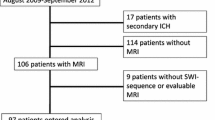Summary
Ninety-two percent of 100 patients with putaminal hemorrhage were hypertensive. Of the eight normotensive patients, seven were substance abusers or had bilateral putaminal hemorrhages. The one other normotensive patient was less than 40 years old. The 100 hemorrhages had the following locations: 1. medial putaminal (17 cases; six were normotensive and less than 40 years old and five were substance abusers); 2. lateral putaminal extending through the external capsule (eleven cases); 3. putaminal-capsular and subcortical white matter (32 cases); 4. putaminal cerebral hemispheric (19 cases); 5. putaminal-thalamic (19 cases); 6. bilateral (two cases). A disproportionate number of black patients suffered hematoma extension to the cerebral hemispheres or thalamus (46%) compared to Caucasians (23%). Overall mortality was 20% (17 blacks and three Caucasians) and occurred in patients with hematoma extension to the thalamus or cerebral hemispheres. Contrast-enhanced CT was performed in all 100 patients and provided no additional diagnostic yield. This indicates limited use for enhanced CT in hypertensive patients with putaminal hemorrhage who have a characteristic appearance of the acute hemorrhage on the nonenhanced CT.
Similar content being viewed by others
References
McCormick WF, Rosenfield DB (1973) Massive brain hemorrhage; a review of 144 cases and an examination of their causes. Stroke 4:946–954
McKissock W, Richardson A, Taylor J (1961) Primary intracerebral hematoma: a controlled trial of surgical and conservative treatment in 180 unselected cases. Lancet II:221–226
Huckman MS, Weinberg PE, Kim KS, et al. (1970) Angiographic and clinicopathologic correlates in basal ganglionic hemorrhage. Radiology 95:79–92
Shea S, Schwartzman RJ (1975) The syndrome of medial versus lateral basal ganglionic hemorrhage. Neurology 25:871
Hier DB, Davis R, Richardson EP, et al. (1977) Hypertensive putaminal hemorrhage. Ann Neurol 1:152–159
Weisberg LA (1979) Computerized tomography in intracranial hemorrhage. Arch Neurol 36:422–426
Joint National Committee (1984) The 1984 report of the Joint National Committee on detection, evaluation and treatment of high blood pressure. Arch Int Med 144:1045–1057
Weisberg LA, Wall M (1984) Small capsular hemorrhages: clinical-computed tomographic correlations. Arch Neurol 41: 1255–1257
Weisberg LA (1984) Caudate Hemorrhage. Arch Neurol 41: 971–974
Weisberg LA (1986) Thalamic hemorrhage. Neurology 36: 1382–1386
Weisberg LA (1985) Subcortical lobar intracerebral hemorrhage: clinical-computed tomographic correlations. J Neurol Neurosurg Psychiatry 48:1078–1084
Kaneko M, Tanaka K, Shimada T, et al. (1983) Long term evaluation of ultra-early operation for hypertensive intracerebral hemorrhage in 100 cases. J Neurosurg 58:838–842
Kanno T, Sano H, Shinomiya Y, et al. (1984) Role of surgery in hypertensive intracerebral hematoma. J Neurosurg 61: 1091–1099
Marshall LF, El-Hefnawi M (1984) Spontancous intracranial hemorrhage. Semin Neurol 4:422–429
Tsementzis SA (1985) Surgical management of intracerebral hematomas. Neurosurgery 16:562–572
Fisher CM (1961) The pathogy and pathogenesis of intracerebral hemorrhage. In: Fields WS (ed) Pathogenesis and treatment of cerebrovascular disease. Thomas, Springfield, p 295
Weisberg LA (1981) Multiple spontaneous intracerebral hematomas: clinical and computed tomographic correlations. Neurology 31:897–900
McCormick WF, Schochet SS (1976) Atlas of cerebrovascular disease. Saunders, Philadelphia, p 125
Case CS, Mohr JP (1980) Supratentorial intracerebral hemorrhage in stroke. In: Barnett HJM, Mohr JP (eds) Churchill-Livingstone, New York, pp 525–548
Mizukami M, Nishijama M, Kin H (1981) Computed tomographic findings of good prognosis for hemiplegia in hypertensive putaminal hemorrhage. Stroke 12:648–652
Kelley RE, Kovacs AG (1986) Horizontal gaze paresis in hemispheric stroke. Stroke 17:1030–1032
Kelley RE, Berger JR, Scheinberg P (1982) Active bleeding in hypertensive intracerebral hemorrhage. Neurology 32:852–856
Fisher CM (1971) Pathological observations in hypertensive cerebral hemorrhage. J Neuropathol Exp Neurol 30:536–550
Russell RWR (1963) Observations on intracerebral aneurysms. Brain 86:425–442
Cole FM, Yates PO (1967) Pseudo-aneurysms in relationship to massive cerebral hemorrhage. J Neurol Neurosurg Psychiatry 30: 61–66
Cole FM, Yates PO (1967) The occurrence and significance of intracerebral micro-aneurysms. J Pathol Bacteriol 93:393–411
Cole FM, Yates P (1957) Intracerebral microaneurysms and small cerebrovascular lesions. Brain 80:759–767
Author information
Authors and Affiliations
Rights and permissions
About this article
Cite this article
Weisberg, L.A., Stazio, A., Elliott, D. et al. Putaminal hemorrhage: Clinical-computed tomographic correlations. Neuroradiology 32, 200–206 (1990). https://doi.org/10.1007/BF00589112
Received:
Issue Date:
DOI: https://doi.org/10.1007/BF00589112




